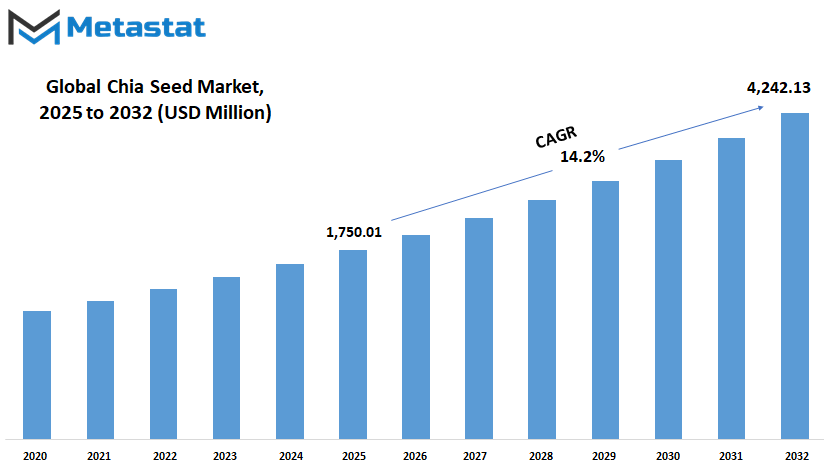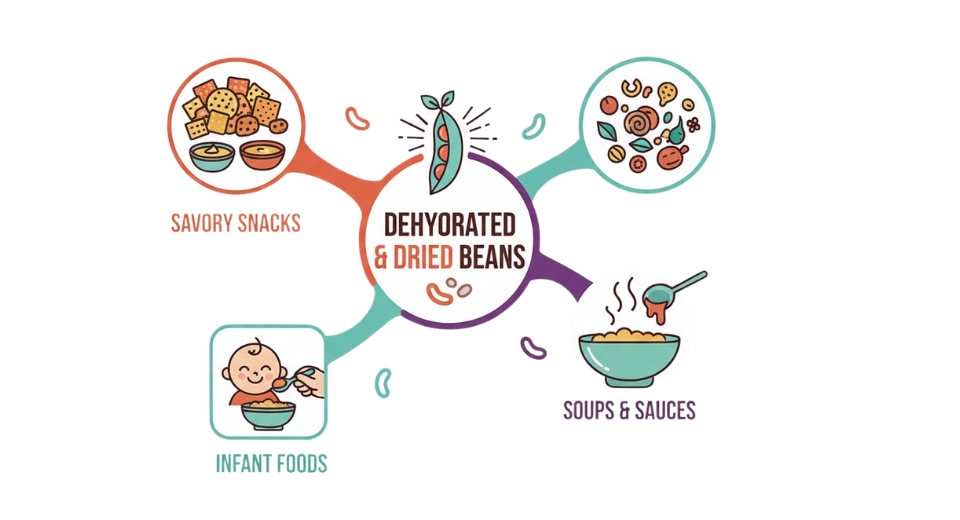MARKET OVERVIEW
The Global Chia Seed market and the industry have received much consideration because of a flower in demand for healthy plant-based nutrient-rich food products. Chia seeds, derived from the Salvia hispanica plant, are now one of the world's most significant sources of omega-3 fatty acids for human nutrition, with considerable amounts of fiber and beneficial antioxidants. The versatile seeds can be utilized in many food and beverage products.
So, as natural and functional food preferences increase, chia seeds are likely to stay relevant in providing health-conscious minimally processed diets to their consumers. It is a global chia seed market that extends well beyond the apparent use of these seeds as an essential ingredient in making functional foods or almost any alternative medicine products.
They are commonly included in snack bars or smoothies, baked goods, and in products suitable for vegans, like non-dairy milks and plant-based yogurts. This is in line with the growing global taste for nutrient-dense foods whose functionality lean toward digestive health, heart health, and overall wellness.
In addition, liquid absorption gel-like formation has made chia seed a wonderful emulsifying factor in energy drinks, nutritional supplements, and meal replacements, where its nutritional claim can best be maximized. Besides food, chia seeds have also been used in personal care products. Chia seed oil is increasingly incorporated into lotions, creams, and hair care formulations due to the fact that it is a moisturizing and antioxidant-rich ingredient.
By then the demand for chia ingredients in cosmetics and personal care will go upward where it is going to be another huge potential raw material because they will keep on adding their value, potency in inflammation reduction, and having health benefits in metabolism. Of course, this will cause further research in the pharmaceutical industry and open up a new arena for chia in therapeutic usage.
The Global Chia Seed Market will differ in its geographical segmentation, with North America and Europe maintaining a lead in demand due to strong health and wellness activities in these regions. Both these regions have embraced chia seeds since long along with health-conscious diets. On the contrary, the consumption of chia seeds in the Asia-Pacific will increase as part of the more extensive superfoods movement due to this region's plant-based and traditional diets. It will continue to grow as awareness about the health benefits of chia increases in these emerging markets such as Latin America and the Middle East.
Global Chia Seed market is estimated to reach $4,242.13 Million by 2032; growing at a CAGR of 14.2% from 2025 to 2032.

GROWTH FACTORS
Plant-based food trends are another support factor for chia seed market growth. The greater the shift against animal products, the wider the demand for nutrient-dense plant-based ingredients. Versatile chia seeds have now claimed major status in several plant-based food products. Existing companies in the food and beverage space are also capitalizing on this movement by manufacturing dairy alternatives, protein bars, and snacks based on chia. Beyond those basic nutrition-oriented ones, functional foods are becoming increasingly popular. These are also significantly contributing to market growth.
The growth of chia seeds, however, faces other constraints which militate against its growth in the market. Climate change has been suddenly throwing weather patterns off their usual course, shaking supply and raw materials. Being very sensitive to environmental conditions, chia cultivation would also suffer from extreme weather events that would cripple production and lead to shortages in the commodity, hence raising competitive prices. Furthermore, chia seeds are not the only nutrient-dense superfoods in the market and are facing strong competition from flaxseed and quinoa. These substitutes provide the same health benefits and end up giving consumers a choice and thus forcing companies to innovate and brand their products differently.
Despite these challenges, the market looks very promising with opportunities. Rising plant-based dairy and bakery product demands have opened more avenues for chia seed application. Manufacturers are actively investigating other potential uses for chia seeds in food products, including non-dairy yogurts, bread, and energy bars. The emergence of chia seeds into other segments of the food industry is expected to provide enormous circumstantial growth in the years to come.
As consumer interests evolve and awareness of nutrition deepens, steady growth can be anticipated in the market. Firms focusing on sustainable sourcing, product innovation, and strategic marketing will dominate this growing market. Progress in food technology and health-oriented consumerism will still maintain chia seeds at the forefront of the future food market.
MARKET SEGMENTATION
By Seed Type
The Global Chia Seed Market is likely to expand at a faster pace when more and more people finally discover the health benefits of the tiny seeds. The growth in nutrition and wellness awareness among consumers is expected to propel demand for chia seeds, which are reputed for their nutrient-packed profiles consisting of fiber, protein, and omega-3 fatty acids. With changes to healthy living, individuals are looking for natural and plant-based ways to appreciate their well-being. This trend would ultimately influence how food producers and suppliers craft their products, thus making chia seeds an important ingredient in various diets globally.
The other dragging factor in the market is the growing inclination of people towards organically grown and chemically untraceable food sources. Nowadays, consumers not only want health benefits out of the products they consume but also want those to be achieved by means of sustainable farming methods. Then there is suddenly an increase in demand for organic chia seeds, which in turn has motivated the farmers and suppliers to increase their production. Besides, food companies are mixing chia seeds into diverse products ranging from energy bars to smoothies, cereals, and baked foods, thereby making the ingredient relatively available to a wider audience.
The chia seeds market is further segmented on the basis of type, which consists of black, white, and brown chia seeds. Particular types have some properties that make them appealing; for example, typically higher oil content for some types and preference for others depending on milder flavor or aesthetic appeal in cooking applications. Black chia seeds are the most popular. They are easy to find and very rich in nutrients, while white chia seeds have the same nutritional benefits as black choruses but are usually selected for their lighter color, which amends particular foods. Brown chia, although more or less classified as having inferior quality than the above varieties, is part of the market; it is, however, less commonly found.
Keeping this in mind, the Global Chia Seed market is likely to find several avenues open to the future, as research spans potential benefits regarding chia consumption. In tandem with plant-eating habits, their call for promoting sustainable food will pour further fuel on this fire. Innovations in food processing and packaging would continue to make chia products attractive to consumers, resulting in new markets to be opened as awareness continues to rise. Increased production and distribution efforts of these products will also be spurred by technological applications to agriculture. This improvement promises brighter futures for the Global Chia Seed market, where advancements will keep changing for the better in the production, marketing, and consumption of these seeds.
By Nature
More changes are expected to be seen in the coming years in the Global Chia Seed market due to changes in the consumption of people toward healthy food items. Due to the increasing importance of nutrition at present, such individuals want all-natural food sources of all essential nutrients, and chia has quickly risen to the most favored option. These seeds are indeed small but a great fiber-, protein- and omega-3 fatty acid-rich food source that can be used in a healthy diet. The trend for food will further increase demand for chia in both production and market aspects.
For the future of this market, distinctions regarding organic and conventional chia seeds may play one of the major roles. More and more people are coming to realize about the source of foods, as well as the way those foods are produced. Organic chia seeds do not have synthetic chemical pesticides or fertilizers for growing, and therefore they appeal to health fans who really want an earth-friendly and natural way of farming. Hence, the market for clean foods will expand as the population increases in choosing cleaner food habits. It will push farmers toward greener practice, which should eventually raise the levels of organic farming.
Even conventional chia seeds dominate the market. These are cheaper and more available, thus can reach wider audiences. Research into improving the quality of conventional chia seed production methods might improve yield as demand grows. New approaches in agriculture technology are expected to enhance the growing conditions, minimize wastage of inputs, and maximize harvesting methods.
Another area that will influence the market is the increasing use of chia seeds in food products. While they are usually taken in smoothies, yogurts, and baked goods, food manufacturers are always looking for new avenues to use chia in everyday food products. With the rising popularity of plant-based diets, chia seeds are likely to become one of the top ingredients used in alternative dairy products, protein bars, and ready-to-eat meals. They could also innovate in their packaging to maintain product freshness and increase shelf life.
The health-conscious consumer will be driving businesses into having much greater transparency at the sourcing and processing methods. Organic, non-GMO, and fair-trade certifications and labels will all get greater towards more educated consumers in the future. Online retail channels will increasingly be at the forefront of market expansion with the continuing proliferation of digital platforms, making chia seeds more widely consumed across the globe.
Notably, the Global Chia Seed market will continue to transform as it grows in line with sustainability, technology, and changing diets regarding how consumers consume food. These changes will require farmers, producers, and retailers to live up to the developments in a bid to stay relevant to the changing needs of the consumers.
By Form
The global chia seed market is poised for steady growth. Growing recognition of its nutritional benefits and multifarious applications will be one of the key drivers of this growth. Chia seeds had been a staple in ancient diets before gaining importance for their high levels of fiber and protein and omega-3 content. As consumers nowadays look for healthier food options, this tiny seed is included in an endless variety of products, such as smoothies, baked goods, and dietary supplements. Under the accelerated awareness of plant-based nutrition, the demand for chia seeds is anticipated to rise further.
One of the major drivers in this market is the different forms in which chia seeds are available. Whole chia seeds are predominantly used due to the convenience of including them directly into the products without any additional processing. Some consumers prefer them to be added to cereals, salads, or beverages where these seeds can absorb liquid and form a gel-like mixture which would be beneficial for digestion and hydration. Whole chia seeds are therefore expected to hold strong demand as consumers lean toward natural and unprocessed food.
Another option to provide those wanting the chia benefits within an easily usable form is ground chia seeds. Ground chia seeds release their nutrients much easier and are thus preferred in most baking and smoothie applications. It can even be used as a substitute for gluten-free flours and thickeners. Such innovations are expected to further incite market demand growth by strengthening product differentiation and encouraging companies to find inventive ways to use ground chia seed in packaged foods, protein bars, and even in plant-based dairy products.
Another segment that shows promise for future growth is chia seed oil. It offers extensive health benefits due to a high concentration of omega-3 fatty acids, thus making it desirable for both food and cosmetic applications. Many skincare and hair care brands are already integrating chia seed oil into their formulations for its moisturizing and anti-inflammatory effects. With increasing traction among consumers for natural beauty and wellness products, demand for this oil is likely to increase, thereby presenting expansion avenues.
Apart from these, other forms of chia-based products are getting attention. These include chia flour, protein concentrates, and specialty blends, which aim to satisfy different dietary requirements. As the exploration of chia-based innovations advances from the companies' side, the market will be witnessing the debut of more functional and convenient offerings.
Prospects for the chia seed market will depend on developments related to production technologies and changing consumer preferences. Since sustainability and health are the prime things on the agenda for consumers, companies will be looking for ways to enhance the quality and accessibility of chia-based products for the future of nutrition.
By Application
Near future will see a growing demand for chia seeds gradually, affecting various industries over the years. Health and wellness awareness among consumers rise, and the food and beverages industry is expected to be the most affected. More companies will incorporate chia seeds in their products, such as adding into smoothies, snack bars, cereals, and baked goods. It is attractive because of having the ability to mingle along in different recipes while adding nutritional value. Changing dietary preferences emphasizing organic and natural foods reinforce incorporating chia seeds into plant-based products.
Use beyond food is extending into personal care and cosmetic products. Their high antioxidant and moisturizing profile renders them precious in skincare formulations. Within a short time frame, several brands started exploring the possible incorporation of chia seed oil in creams, lotions, and serums to meet the needs of consumers looking for natural alternatives. Under this backdrop, promoting chia beauty products for their environment-friendly and skin-friendly properties will remain the trend in all likelihood.
Another fast-expanding area has to do with animal feed and pet food. Changing the way people think about nutrition for their pets has opened the door to chia seeds being introduced into specialized pet diets. Healthy digestion, a better coat, and other benefits can have considerable appeal to pet owners in search of a more natural supplement for their pets. Increasingly, farmers may start adding chia seeds in the formulations of animal feed, which will boost the healthy state of livestock as part of the move to more balanced and nutrient-rich animal nutrition.
The nutritional and dietary supplements sector is expected to expand. The benefits of chia seeds for omega-3, fiber, and protein content have made chia seeds one of the top choices for health-conscious consumers. With more and more individuals shifting to active lifestyles and looking for easy ways to improve their diets, the consumption of chia-based supplements will continue to grow. These products will most probably be available in capsules, powders, or fortified drinks, enticing individuals searching for plant-based sources of essential nutrients.
Other uses, such as pharmaceuticals and specialized health products, will reveal themselves as research continues. There still exist many new benefits of the chia seed and its scientific investigation. With continual advancements and also changing consumer preferences, the market looks promising in the future, hence opening up doors of a number of opportunities across various industries.
|
Forecast Period |
2025-2032 |
|
Market Size in 2025 |
$1,750.01 million |
|
Market Size by 2032 |
$4,242.13 Million |
|
Growth Rate from 2025 to 2032 |
14.2% |
|
Base Year |
2024 |
|
Regions Covered |
North America, Europe, Asia-Pacific, South America, Middle East & Africa |
REGIONAL ANALYSIS
The Global Chia Seed Market continues to burgeon with increasing awareness of health and nutrition among consumers. It is enhanced varyingly across regions by the different climates, agricultural methods, market demands for plant foods, and government policy. The change in feeding habits, advancing agricultural technologies, and trade agreements between the two countries that affect the cross-border movement of these seeds will shape the expansion of the market.
Increasingly, North Americans make organic and plant-based products their choice, hence commanding the market. The relative importance of the U.S. applies further; the health food industry is so established in the country that consumers are inclined to seek out superfoods that make them feel better overall. Functional foods are gaining traction in Canada as well, and in Mexico, creating an opportunity for the country to be involved in production and consumption of chia seeds. As awareness increases, North America is also expected to have intensified investments in sustainable farming and product innovations.
In Europe, health-conscious consumers seeking natural alternatives to processed food would contribute a significant portion of the market. The demand for the superseed is steadily mushrooming in countries such as Germany, France, and the UK, whose citizens are fitness and balanced diet conscious. The EU regulatory framework ensures product quality and facilitates trade, hence, facilitating entry for new products based on chia seeds. In the long run, therefore, more consumers in this region are likely to incorporate chia seeds not only into their traditional foods and beverages but also into fortified foods and beverages.
When it comes to nutrient-dense food demands because of changing lifestyles, Asia-Pacific is the region that has the most to offer prospects. China and India find good mates in having large populations with healthy eating preferences. However, Japan and South Korea have been opening the door already by putting superfoods into their diets. Agricultural capacity for the region is being added, which could allow for more local production. Increased urbanization and income per capita would result in more people turning to chia seed for health benefits, thus making way for further market penetration.
In contrast, South America plays a major role in chia seed production in Brazil and Argentina as an important producer of chia seeds. The combination of conducive climatic conditions and a large expanse of agricultural land makes the area a strong exporter; moreover, the trend of increasing local consumption is backed by a growing understanding of the nutritional advantages involved. Over time, improved processing and better links for global trade will allow South America to solidify its position in the market.
Emerging markets Middle East and Africa, where increasing demand accompanies gradually healthier lifestyles, will begin to emerge more prominently in recent times. Chia seeds have been accepted in the Gulf Cooperation Council (GCC) countries as a product used for plant-based nutrition. South Africa is also starting to cultivate a wellness mentality in people's diets, thus contributing to the market growth.

COMPETITIVE PLAYERS
This chia seed industry is gearing up into a global market powered by the nutrition awareness about this seed and later lifestyle modifications. So far, these companies spend a lot of time upgrading towards changing lifestyles of consumers and competing for stronghold. It says that the future of the Global Chia Seed Market will be defined by innovation, sustainable development, and expanding distribution chains.
Some of the leading companies have also established themselves as part of the niche segment, supplying a variety of chia products targeting the ever-increasing demand. The Chia Co., Mamma Chia, Nutiva Inc., and Benexia are a few of the big names that have made a reputation within this industry. They list premium sources of seeds and then create unique product lines that would appeal to health-conscious consumers. As people are becoming more interested in plant-based nutrition, the entry of more businesses into this market ground will increase competition.
One of the many issues with this industry is sustainability, and companies such as Navitas Organics, Garden of Life, and Spectrum Essentials have focused on ethical sourcing and environmentally sustainable practices. Many brands are working towards organic certification and equitable trade partnerships, which help ensure that the goods they sell conform to the values of the modern buyer. These are the kinds of practices that will help businesses overcome the majority with their market strategies as more importance is placed on the product's sustainability.
Innovation will be one of the huge determinants of who will lead the future market. The well-renowned companies, including those mentioned as Bob's Red Mill Natural Foods, Terrasoul Superfoods, and Healthworks, will be widening their product ranges in tune with changing consumer tastes. These will range from beverages and snack bars enriched with chia to protein blends for baking. New health benefits of chia seeds as found and published through research would encourage manufacturers to come up with products that would derive its benefit through having these seeds fortified.
Global extension is another prime strategy on the cards for business diversifiers. Companies like Naturkost Übelhör, Nourish You, and Sesajal SA De CV are all breaking their distribution networks to enter new markets. The most demanding regions for chia seed consumption are yet to be developed, so the companies that will be able to design an efficient supply chain and, where necessary, local relation partnerships will be the major beneficiaries. Long-term success will hinge on the ability to navigate various regulations and consumer preferences.
With this increasing consumer demand, even more brands such as very well-known names including Vega Produce LLC, Organic India, Now Foods, Sunfood Superfoods, Chia Bia, Viva Naturals, and Naturya are going to compete even more. The way forward will be through partnerships with retailers and improved digital marketing, and product diversification.
Chia Seed Market Key Segments:
By Seed Type
- Black Chia Seeds
- White Chia Seeds
- Brown Chia Seeds
By Nature
- Organic
- Conventional
By Form
- Whole Chia Seeds
- Grounded Chia Seeds
- Chia Seed Oil
- Other
By Application
- Food and Beverages Sector
- Personal Care Products and Cosmetics Sector
- Animal Feed and Pet Food Sector
- Nutritional and Dietary Supplements Sector
- Other
Key Global Chia Seed Industry Players
- The Chia Co.
- Mamma Chia
- Nutiva Inc.
- Benexia
- Navitas Organics
- Garden of Life
- Spectrum Essentials
- Bob’s Red Mill Natural Foods
- Terrasoul Superfoods
- Healthworks
- Naturkost Übelhör
- Nourish You
- Sesajal SA De CV
- Vega Produce LLC
- Organic India
- Now Foods
- Sunfood Superfoods
- Chia Bia
- Viva Naturals
- Naturya
WHAT REPORT PROVIDES
- Full in-depth analysis of the parent Industry
- Important changes in market and its dynamics
- Segmentation details of the market
- Former, on-going, and projected market analysis in terms of volume and value
- Assessment of niche industry developments
- Market share analysis
- Key strategies of major players
- Emerging segments and regional growth potential








 US: +1 3023308252
US: +1 3023308252






